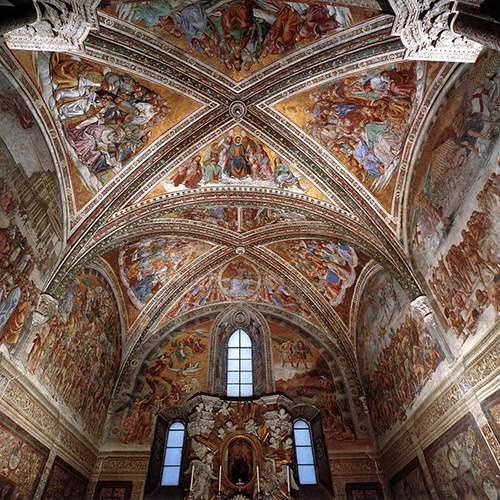
Chapel of San Brizio, Duomo, Orvieto
Art historian Sophia D’Addio of Columbia University follows up her 2023 exploration of Italian cathedrals and basilicas in several major cities by going off the beaten path. In a splendidly illustrated full-day seminar, she focuses on four sites of great importance located in the regions of Umbria, Emilia-Romagna, and Le Marche: the churches of Assisi, Orvieto, Parma, and Loreto, which represent some of Italy’s greatest repositories of sacred art.
Built during the Romanesque, Gothic, and Renaissance periods, these majestic churches—several of which became major pilgrimage destinations—were adorned with complex fresco cycles and sculptural programs executed by some of the most renowned artists of their respective periods.
10–11 a.m. The Basilica of Saint Francis of Assisi
Shortly after the death of Saint Francis in 1612, a massive basilica dedicated to him was begun in his hometown of Assisi. Many illustrious painters were called to decorate its spaces with frescoes including Cimabue, Pietro Lorenzetti, and possibly even the young Giotto (although this attribution has been hotly debated).
11:15 a.m.–12:15 p.m. The Cathedral of Orvieto
From Lorenzo Maitani’s intricately carved reliefs of the Gothic façade to Luca Signorelli’s Renaissance frescoes in the San Brizio Chapel to Francesco Mochi’s early Baroque sculptures, the cathedral of Orvieto was adorned over the centuries with remarkable works of sacred art.
12:15–12:45 p.m. Break
12:45–1:45 p.m. The Cathedral of Parma
The majestic frescoes of Lattanzio Gambara, Correggio, and Girolamo Mazzola Bedoli respectively fill the walls, cupola, and apse of the cathedral of Parma, rendering it a spectacular showcase of 16th-century painting. Benedetto Antelami’s early 13th-century sculptures decorate the Baptistery, located just outside the cathedral.
2 –3 p.m. The Basilica of Santa Casa in Loreto
The Basilica of the Santa Casa was commissioned in 1468 to enshrine the “Santa Casa,” or the holy house of the Virgin Mary. According to popular tradition, angels transported the rudimentary house from Nazareth to the shores of the Adriatic in the 1290s, and a strong devotional following grew around it. The basilica would continue to be enlarged and adorned through numerous papal commissions over the centuries with architectural interventions of Giuliano de Maiano, Giuliano da Sangallo, and Donato Bramante; the frescoes of Luca Signorelli and Melozzo da Forli; and the sculptures of Andrea Sansovino and others.
World Art History Certificate elective: Earn 1 credit*
General Information
*Enrolled participants in the World Art History Certificate Program receive 1 elective credit. Not yet enrolled? Learn about the program, its benefits, and how to register here.